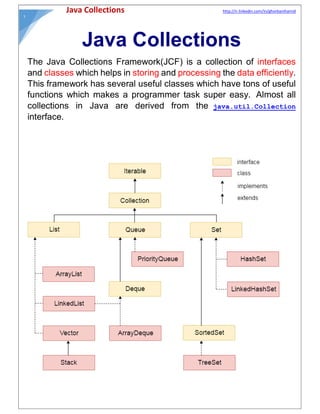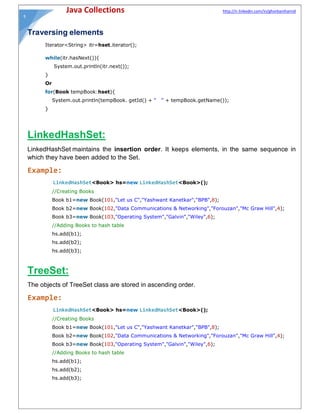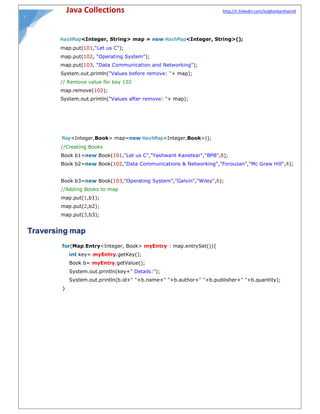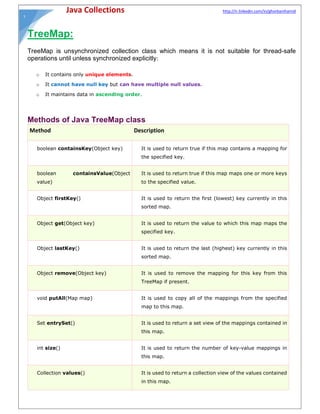The Java Collections Framework provides classes and interfaces that help store and manipulate collections of objects. The main collection interfaces are List, Set, and Map. Lists allow duplicate elements and access by index. Common List implementations are ArrayList and LinkedList. Sets do not allow duplicates. Common Set implementations are HashSet, LinkedHashSet, and TreeSet. Maps store objects in key-value pairs and cannot have duplicate keys. Common Map implementations are HashMap, TreeMap, and LinkedHashMap.



![http://ir.linkedin.com/in/ghorbanihamidava CollectionsJ
۴
Iterator loop:
java.lang.Iterable
A class that implements the Iterable can be used with the new for-loop.
Iterator is used for iterating (looping) various collection classes.
Example:
String sArray[] = new String[] { "Array 1", "Array 2", "Array 3" };
// convert array to list
List<String> lList = Arrays.asList(sArray);
// for loop
System.out.println("#2 for");
for (int i = 0; i < lList.size(); i++) {
System.out.println(lList.get(i));
}
// for loop advance
System.out.println("#3 for advance");
for (String temp : lList) {
System.out.println(temp);
}
//Traversing elements using Iterator loop
Iterator<String> iterator = lList.iterator();
while (iterator.hasNext()) {
System.out.println(iterator.next());
}](https://image.slidesharecdn.com/javacollections-171010154557/85/Java-collections-4-320.jpg)
![http://ir.linkedin.com/in/ghorbanihamidava CollectionsJ
۵
Vector:
Like ArrayList it also maintains insertion order but it is rarely used in non-thread environment as it
is synchronized and due to which it gives poor performance in searching, adding, delete and update of
its elements.
1) Vector<Integer> vector = new Vector<Integer>();
2)
// Vector of initial capacity of 2
Vector<String> vec = new Vector<String>(2);
3)
// Vector object = new vector(int initialcapacity, int capacityIncrement)
/* It means upon insertion of 5th element the size would be 10 (4+6) and on 11th
insertion it would be 16(10+6). */
Vector vec= new Vector(4, 6)
/* Adding elements to a vector*/
vec.addElement("Apple");
vec.addElement("Orange");
vec.addElement("Mango");
vec.addElement("Fig");
Method Description
void addElement(Object obj)
Adds the specified component to the end of this vector, increasing
its size by one.
Object elementAt(int index) Returns the component at the specified index.
int capacity()
Returns the current capacity of this vector. capacity means the
length of its internal data array, kept in the field elementData of this
vector. By default vector doubles its capacity
int size() Returns the number of components in this vector.
void setSize(int newSize) Sets the size of this vector.
void trimToSize() Trims the capacity of this vector to be the vector's current size.
void setElementAt(Object obj, int index)
Sets the component at the specified index of this vector to be the
specified object.
Enumeration elements() Returns an enumeration of the components of this vector.
void copyInto(Object[] anArray) Copies the components of this vector into the specified array.
void clear() Removes all of the elements from this vector.
Object[] toArray()
Returns an array containing all of the elements in this vector in the
correct order.](https://image.slidesharecdn.com/javacollections-171010154557/85/Java-collections-5-320.jpg)


![http://ir.linkedin.com/in/ghorbanihamidava CollectionsJ
٨
Example 1:
HashSet<String> hset = new HashSet<String>();
// Adding elements to the HashSet
hset.add("Apple");
hset.add("Orange");
hset.add("Fig");
//Addition of duplicate elements
hset.add("Apple");
hset.add("Mango");
//Addition of null values
hset.add(null);
//Displaying HashSet elements
System.out.println(hset);
Example 2:
public class Book {
int id, quantity;
String name,author,publisher;
public Book(int id, String name, String author, String publisher, int quantity) {
this.id = id;
this.name = name;
this.author = author;
this.publisher = publisher;
this.quantity = quantity;
}
}
public class HashSetExample {
public static void main(String[] args) {
HashSet<Book> hset=new HashSet<Book>();
//Creating Books
Book b1=new Book(101,"Let us C","Yashwant Kanetkar","BPB",8);
Book b2=new Book(102,"Data Communications & Networking","Forouzan","Mc Graw Hill",4);
Book b3=new Book(103,"Operating System","Galvin","Wiley",6);
//Adding Books to HashSet
hset.add(b1);
hset.add(b2);
hset.add(b3);
}
}](https://image.slidesharecdn.com/javacollections-171010154557/85/Java-collections-8-320.jpg)





